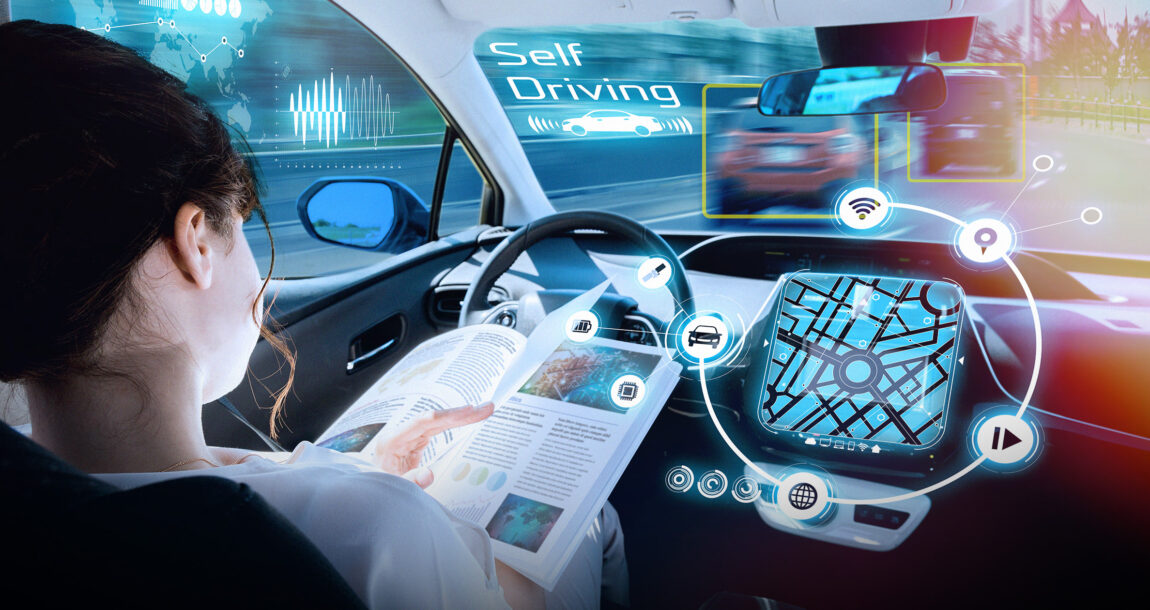Driving into the future: Navigating the evolution of auto insurance

The velocity of change in the auto insurance market is punching the accelerator. The transformation is happening as vehicles become smarter, connected and electrified—and sales of traditional, fuel-powered cars are projected to decline.

Embedded auto insurance and UBI on the road ahead
Automakers, notably Tesla and Toyota, are beginning to embed insurance directly with purchasing a new car – and edging into the risk-bearing side of the business. According to Insider Intelligence, 79% of U.S. consumers would consider buying insurance bundled with a vehicle. By the end of the decade, up to 30% of personal auto premiums are expected to be generated through embedded insurance.
Insurers have the opportunity to partner with automakers and go beyond embedded insurance, ingesting data sources to provide end-to-end solutions that are more holistic. This includes telematics-based "pay-as-you-drive" auto policies. According to J.D. Power's 2023 U.S. Auto
Insurance Study: Customers unhappy with recent rate increases are accelerating the adoption of usage-based insurance. Today, 17% of auto insurance is UBI, and demand is growing fast.
Cognitive connected coverage
Current forms of UBI could soon be replaced by "cognitive connected coverage." Think artificial intelligence-based technologies that go beyond recognizing that you slammed on the brakes, for example, to understand that you did so to avoid a collision. When accidents occur, the first notice of loss (FNOL) could be initiated automatically, and all pertinent telemetric data could be relayed to the insurer. The technology could summon a tow truck or first responders based on connected diagnostics data.
These same technologies promise to open new avenues for creating value as cars evolve into information-enveloped transportation bubbles that offer drivers and passengers a full range of services enhanced by continuous connectivity, AI and intuitive interfaces.
Consumers are highly likely to be interested in such services. After purchasing a vehicle, 39% of car buyers say they want to activate additional digital services. That figure rises to nearly 50% for owners of premium brand vehicles.
Autonomous driving and auto insurance
Over the next 10 years, we expect autonomous technology to evolve and further integrate into personal vehicles, public transit and the transportation of goods. Sales of new Level 2 (partial autonomy) and Level 3 (conditional autonomy) are on pace to account for 63% and 4% of new vehicle sales worldwide, respectively, by the latter half of the decade.
Entire commercial fleets with Level 3 (conditional autonomy) and Level 4 (high autonomy) could be on the roads in the decade's second half.
These trends could see a shift in insurance liability from the human driver to the commercial party associated with the autonomous vehicle technology and capabilities—often the original equipment manufacturer and software providers.
Autonomous, connected car platforms will do more than navigate. EV robo-taxis such as Google-backed Waymo and GM-backed Cruise, shuttles and more will set the stage for far more autonomy and new forms of connectivity that solve many of mobility's most substantive pain points—road congestion, parking hassles, pollution and more—with plenty for insurers to cover.
Ditching personal vehicles
These aren't the only changes on the horizon. By 2050, 80% of consumers worldwide will reside in cities. As a result, many consumers will forgo car ownership altogether. Only 13.7 million vehicles were sold in the U.S. last year, a drop of 8% from the previous year and nearly 20% lower than 2019. At the same time, ride-hailing services have been growing at 60% per year. As these trends continue, the impact on insurers will be profound.
KPMG estimates that by 2040, only 40% of overall auto premiums will be generated through personal lines worldwide.
Auto insurance adapts to new forms of mobility
Insurers must innovate in this rapidly evolving landscape to support a shift to multimodal and commercial coverage models. They'll need to embrace new service models such as Allstate's use of SparkCharge portable EV charging stations in roadside assistance offerings, coverage for micro-mobility startups with rapidly growing fleets of e-bikes, e-scooters, quadricycles, golf carts and more, as well as new forms of car rental companies.
It will also mean developing new "mobility-as-a-service" offerings that cover mobility journeys instead of assets. Whether for personal, commercial, or hybrid use, these models include coverage for the policyholder's use of their personal, subscribed or on-demand car ride to the train station as part of their morning commute (collision, injury, personal property). According to Capgemini, 42% of policyholders worldwide already want a single policy that covers them irrespective of mode of transportation. Only 33% of insurers currently have one.
A future fueled by data
It's no stretch to say that for insurers, this future of mobility is about one thing above all else: data. Over the next decade, success in this sector will be measured by the ability to leverage exponential amounts of real-time driving and traffic data from a rapidly expanding universe of sources.
In addition to data piped from onboard systems and smartphone-based apps, insurers will also need ecosystems to draw and use data from public transportation systems. In the event of claim-triggering events, they'll also need the ability to leverage data from nearby camera feeds, radar, and IoT sensors to access accurate, real-time data needed to simplify, streamline and automate the claims journey.
Technologies will help further shift insurance from a repair-and-replace to a predict-and-prevent business. They'll also transform today's fragmented, complex world of claims as insurers recognize their mobility ecosystem must include seamless integration and data flow between the carrier and their service and repair shop networks to expedite and streamline the claims process.
What it takes to win the future
Data and the ability to make it actionable will require an intelligent insurance platform that enables meaningful insights by integrating real-time data across mobility ecosystems.
That means one that combines core, data, and digital using powerful forms of AI that integrate with mobility ecosystem players (OEMs, third-party data and service providers, etc.) to interpret an expanding universe of data and support all transactions therein, from quote to claim and beyond.
Companies with this platform infrastructure and proper data ecosystems will have a marked advantage in pivoting and capturing lucrative new opportunities.
Laura Drabik is a frequent commentator on issues of transformation and innovation in the property/casualty insurance industry and chief evangelist at Guidewire. Contact her at [email protected].
© Entire contents copyright 2024 by InsuranceNewsNet.com Inc. All rights reserved. No part of this article may be reprinted without the expressed written consent from InsuranceNewsNet.com.





Maryland commissioner on NAIC climate effort: It’s time to take action
Life insurance premium growth sets another record in 2023, LIMRA finds
Advisor News
- D.C. Digest: 'One Big Beautiful Bill' rebranded 'Working Families Tax Cut'
- OBBBA and New Year’s resolutions
- Do strong financial habits lead to better health?
- Winona County approves 11% tax levy increase
- Top firms’ 2026 market forecasts every financial advisor should know
More Advisor NewsAnnuity News
- Judge denies new trial for Jeffrey Cutter on Advisors Act violation
- Great-West Life & Annuity Insurance Company Trademark Application for “EMPOWER BENEFIT CONSULTING SERVICES” Filed: Great-West Life & Annuity Insurance Company
- 2025 Top 5 Annuity Stories: Lawsuits, layoffs and Brighthouse sale rumors
- An Application for the Trademark “DYNAMIC RETIREMENT MANAGER” Has Been Filed by Great-West Life & Annuity Insurance Company: Great-West Life & Annuity Insurance Company
- Product understanding will drive the future of insurance
More Annuity NewsHealth/Employee Benefits News
- ‘Egregious’: Idaho insurer says planned hospital’s practices could drive up costs
- D.C. DIGEST
- Medicaid agencies stepping up outreach
- D.C. Digest: 'One Big Beautiful Bill' rebranded 'Working Families Tax Cut'
- State employees got insurance without premiums
More Health/Employee Benefits NewsLife Insurance News